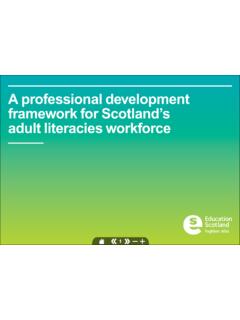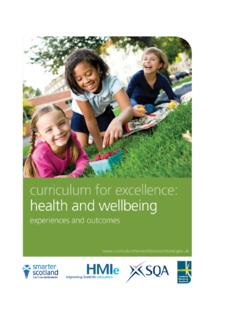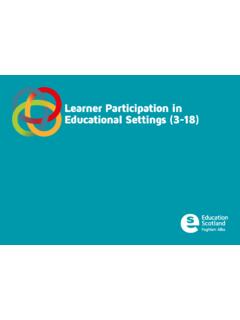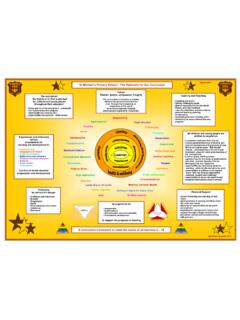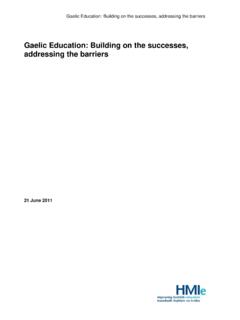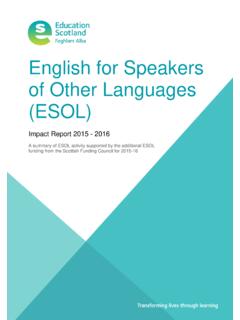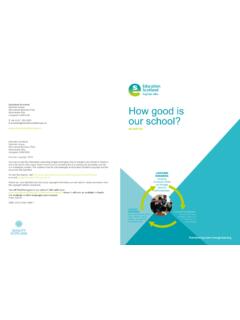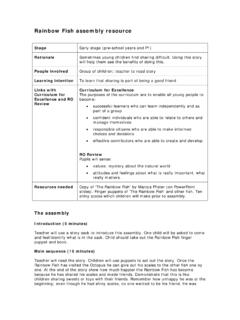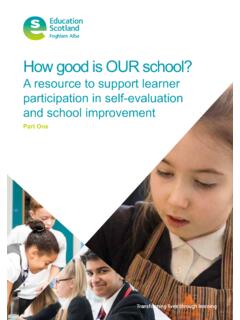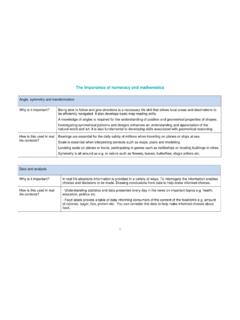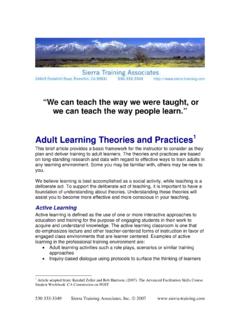Transcription of Health and wellbeing - Education Scotland
1 Health and wellbeing principles and practice Curriculum for Excellence has an important role to play in promoting the Health and wellbeing of children and young people and of all of those in the educational communities to which they belong. This paper is intended to support discussion and planning between practitioners in all sectors and services and in local authorities. This paper is closely related to the Guidance on the Schools ( Health Promotion and Nutrition) ( Scotland ) Act 2007 ( ). Together, these documents describe the expectations upon individuals, schools and local authorities for promoting the Health and wellbeing of children and young people. What are the main purposes of learning in Health and wellbeing ? Learning in Health and wellbeing ensures that children and young people develop the knowledge and understanding, skills, capabilities and attributes which they need for mental, emotional, social and physical wellbeing now and in the future.
2 Learning through Health and wellbeing enables children and young people to: make informed decisions in order to improve their mental, emotional, social and physical wellbeing experience challenge and enjoyment experience positive aspects of healthy living and activity for themselves apply their mental, emotional, social and physical skills to pursue a healthy lifestyle make a successful move to the next stage of Education or work establish a pattern of Health and wellbeing which will be sustained into adult life, and which will help to promote the Health and wellbeing of the next generation of Scottish children. It also enables some to perform at high levels in sport or prepare for careers within the Health and leisure industries. What does the Health and wellbeing framework mean for practitioners?
3 The statements of experiences and outcomes in Health and wellbeing reflect a holistic approach to promoting the Health and wellbeing of all children and young people. They are consistent with the United Nations Convention on the Rights of the Child, which sets out the right for all children and young people to have access to appropriate Health services and to have their Health and wellbeing promoted. They build on the considerable work of Health Promoting Schools and the publication of Being Well, Doing Well which underlines the importance of a Health enhancing' school ethos one characterised by care, respect, participation, responsibility and fairness for all. The framework complements the duty in the Schools ( Health Promotion and Nutrition) ( Scotland ) Act 2007 for Scottish Ministers and local authorities to endeavour to ensure that all schools are Health promoting.
4 Children and young people should feel happy, safe, respected and included in the school environment and all staff should be proactive in promoting positive behaviour in the classroom, playground and the wider school community. Robust policies and practice which ensure the safety and wellbeing of children should already be in place. In addition, there are many ways in which establishments can assist young people. These include peer support, buddies, breakfast or lunch clubs, safe areas, mentors, pupil support staff and extended support teams. Good Health and wellbeing is central to effective learning and preparation for successful independent living. This aspiration for every child and young person can only be met through a concerted approach: schools and their partners working together closely to plan their programmes for Health and wellbeing explicitly, taking account of local circumstances and individual needs.
5 Planning to provide and manage the many different and complementary contributions may be challenging but is needed. Each individual practitioner must be aware of his or her roles and responsibilities. The diagram below illustrates this shared vision and common goal. Health and wellbeing : principles and practice 1. Learning through Health and wellbeing promotes confidence, independent thinking and positive attitudes and dispositions. Because of this, it is the responsibility of every teacher to contribute to learning and development in this area. Building the Curriculum 1. How is the Health and wellbeing framework structured? The framework begins by describing features of the environment for learning which will support and nurture the Health and wellbeing of children and young people, including a positive ethos and relationships, and participation in activities which promote a healthy lifestyle.
6 These statements are intended to help to inform planning and practice within establishments or clusters and also by individual practitioners. The statements of experiences and outcomes are then structured into the following organisers: Mental, emotional, social and physical wellbeing Planning for choices and changes Physical Education , physical activity and sport Food and Health Substance misuse Relationships, sexual Health and parenthood. Health and wellbeing : principles and practice 2. The aspects of the Health and wellbeing framework which are the responsibility of all adults who are working together to support the learning and development of children and young people are identified through the use of italics. Many of the experiences and outcomes span two or more levels; some are written to span from early to fourth because they are applicable throughout life.
7 All of these should be revisited regularly in ways which take account of the stage of development and understanding of each child and young person and are relevant and realistic for them. What are practitioners' roles and responsibilities across Health and wellbeing ? Some contributions are the responsibility of all, while other contributions relate to specific stages or are more specialised. Health and wellbeing across learning: the responsibilities of all practitioners Everyone within each learning community, whatever their contact with children and young people may be, shares the responsibility for creating a positive ethos and climate of respect and trust one in which everyone can make a positive contribution to the wellbeing of each individual within the school and the wider community.
8 There are many ways in which establishments can assist young people. These include peer support, buddies, breakfast or lunch clubs, safe areas, mentors, pupil support staff and extended support teams. The responsibilities include individuals' contributions to the features set out in the introductory statements, and experiences and outcomes in mental, emotional, social and physical wellbeing , planning for choices and changes, and relationships. They include each practitioner's role in establishing open, positive, supportive relationships across the school community, where children and young people will feel that they are listened to, and where they feel secure in their ability to discuss sensitive aspects of their lives; in promoting a climate in which children and young people feel safe and secure; in modelling behaviour which promotes Health and wellbeing , and encouraging it in others through using learning and teaching methodologies which promote effective learning, and by being sensitive and responsive to the wellbeing of each child and young person.
9 Practical responsibilities include understanding of anti-discriminatory, anti-bullying and child protection policies by all staff and knowledge of the steps to be taken in any given situation, including appropriate referral. Focused programmes Children will experience certain aspects of Health and wellbeing through focused programmes such as personal and social Education programmes. Within these programmes, schools will often draw on the expertise of others. For example, when substance misuse is being considered, specialists within and outwith the learning community working together are able to ensure that children and young people learn in the most effective ways. Subject teachers, including teachers of home economics and physical Education , play a very important role in the teaching and learning of Health and wellbeing through the experiences and outcomes for food and Health , and physical Education , physical activity and sport.
10 Sports specialists play an important part in physical activity and sport provision. Partnership working across sectors and services Children's and young people's learning in Health and wellbeing benefits strongly from partnership working between teachers and colleagues such as home link staff, Health professionals, educational psychologists and sports coaches who can make complementary contributions through their specialist expertise and knowledge. Health and wellbeing : principles and practice 3. Personal support for children and young people The Health and wellbeing of every child and young person is greatly enhanced through the individual support and pastoral care which they receive through having an identified member of staff who knows and understands them and can support them in facing changes and challenges and in making choices.
